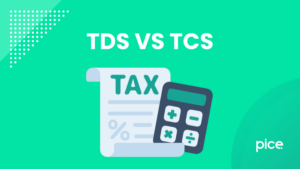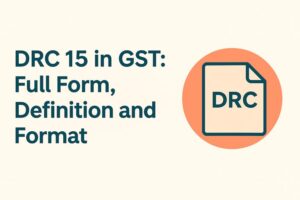Creating Credit Note Under GST
- 9 Sep 24
- 13 mins

Creating Credit Note Under GST
- What Is a Credit Note Under GST?
- Reasons for Issuing a Credit Note
- When Should a Credit Note Be Issued Under GST?
- Credit Note Format and Structure
- How to Create a Credit Note?
- Process for Issuing a Credit Note Under GST
- Details to Include in a Credit Note for GST Returns
- Benefits of Using a Credit Note Format in GST
- Adjusting Tax Liability with a Credit Note Under GST
- Final Word
Key Takeaways
- A credit note under GST is a document issued to correct errors in tax invoices, reduce tax liabilities, or adjust for returned goods or discounts.
- Credit notes must be issued before filing GST returns and reported in the appropriate month to ensure proper tax adjustments.
- Key reasons for issuing a credit note include overcharges, return of goods, post-sale discounts, and changes in the quantity ordered.
- Credit notes help maintain accurate financial records, prevent billing conflicts, and correct tax liabilities for both buyers and sellers.
- Properly formatted credit notes must include critical details such as GSTIN, tax rate, amount credited, and a unique serial number.
Errors in tax invoices from the supplier’s end when issuing them are quite common. To rectify the errors and make the necessary adjustments in the tax liability, buyers or sellers can issue credit notes. The blog highlights the steps of how to create a credit note in the GST portal and other crucial details associated. Read on to know more!
What Is a Credit Note Under GST?
A credit note under GST is a crucial financial document that aids in the reduction or adjustment of tax liability. A GST-registered person can issue it to rectify errors in prices or adjust the taxable quantity of goods. The credit memo contains important details such as the amount credited, the reason for issuing them, details of buyer and seller and so on.
💡 If you want to pay your GST with Credit Card, then download Pice Business Payment App. Pice is the one stop app for all paying all your business expenses.
Understanding Credit Notes with an Example
For example, consider that a seller issued a ₹1,000 tax invoice to a buyer during the purchase of goods. However, later the supplier discovered that they had overcharged the buyer by ₹200 in the form of GST.
In such scenarios, to rectify their mistakes, they will have to issue a credit note of ₹200 to make the necessary adjustments in the tax liability. There can be various reasons for issuing a credit memo. You can learn them in detail in the next section of the blog.
Reasons for Issuing a Credit Note
According to Section 34(1) of the CGST Act, after the issue of a tax invoice, the issuer needs to amend it in order to reduce the tax liability. Some of the common reasons for which one can issue a credit note include:
- Return of Purchased Goods: Buyers can issue a credit memo in case they want to return the purchased goods due to their poor quality.
- Payment of Additional Charges: In case the seller charges a higher amount than the original one, they issue a credit note to return the extra amount.
- Availability of Post-sale Discount: If a GST-registered supplier offers a post-sale discount on purchases, they can issue a credit memo to initiate the return of funds.
- Cancellation of Pending Payments: If a buyer decides to cancel the pending payments under certain circumstances, they can issue a credit note.
- Due to Change in Order of Goods: A buyer can issue a credit memo if they decide to increase or decrease the quantity of goods they have purchased.
Apart from knowing the reasons, you should also be well aware of when you can issue a credit note to rectify issues in tax invoices.
When Should a Credit Note Be Issued Under GST?
Buyers or sellers both can issue a credit note under various circumstances. These situations include the return of goods due to quality issues, altering the quantity of the goods, returning the extra money in case of a mistake in the original invoice, the applicability of post-sales discounts and so on.
You should note that there is no time limit associated with the issuance of a credit memo. However, it is a must that the credit note details are mentioned during the GST returns filing process. Hence, if a buyer or seller wishes to issue a credit note, they must do so before filing GST returns, preferably in the same financial year.
Before filing out the credit memo, make sure that you are aware of the structure so that you can fill out the credit note accurately, without missing out on crucial information.
Credit Note Format and Structure
Usually, there is no set credit note template. However, the issuer must mention certain crucial details when filing it to ensure proper recording. The required information for credit note entry includes:
- The name, address and GSTIN of the GST-registered person
- Nature and type of document
- A unique consecutive serial number
- The date of issue of a credit note
- Personal Information
- Date of the issue of original tax invoice and its serial number
- The value of the taxable outward supplies, the amount credited to the recipient and the rate of tax
- The digital signature of the supplier or their authorised representative must be there
Now that you are aware of the format, you can proceed with the steps to create them in one go.
How to Create a Credit Note?
Framing a credit memo becomes extremely easy once you are aware of the steps involved. Following are some hassle-free steps to create a credit note:
Step 1: Determine the reason for the issuance of credit notes. This can be due to damages in delivered goods, errors in original invoices, changes in order and so on.
Step 2: Go through the GST laws and determine if you are creating the credit memo within the given time frame. Moreover, check other eligibility clauses associated.
Step 3: Create a new document and save it by the name ‘Credit Note’. In addition, assign a unique identification number to it.
Step 4: Make a table to add all the relevant details in them such as date, invoice number and value. Moreover, attach all the invoices present.
Step 5: Add descriptions along with the details of the quality and value of the goods or services for which you are creating a credit memo.
Step 6: Check the original amount from the invoices present and from it deduct the value of goods or services being credited. This will give you the amount for the Credit Note.
Step 7: In the document created, specify the reasons for generating a Credit Note. Further, provide a copy of this document to the recipient and keep a copy for your reference.
Step 8: Once done, make the changes applicable to the GST Returns that you have already filed. Also, adjust the tax amount and pay the extra amount if needed.
After you are done with creating a credit memorandum, know how you can issue one at a time of need.
Process for Issuing a Credit Note Under GST
Following is a step-by-step procedure for generating a credit memorandum under GST:
Step 1: Browse through the available credit memorandum template and choose the one that you want to use.
Step 2: After that, add your company’s logo to this document at the available location.
Step 3: Next, accurately enter the unique identification number of your credit memorandum along with the date of issue.
Step 4: Input the reference number to which your credit note has been issued and the details of the invoices as applicable.
Step 5: Add the details of the GSTIN of the supplier as well as the customer. Mention the supply location.
Step 6: Go through the form to recheck and confirm if all the details are in place and finally save the credit memo.
Once done, you can use this credit memorandum to make necessary adjustments to your tax liability.
Details to Include in a Credit Note for GST Returns
Taxpayers must add the details of credit notes issued before filing monthly GSTR-1, to ensure proper filing. Additionally, they should mention the name, address and GSTIN of the supplier, the unique consecutive serial number, the nature and type of document, the date of issue of the credit note and other personal information.
It reflects the name, address, and GSTIN or Unique Identification Number of a registered recipient, delivery address of goods, along with the name of the State and its code, which need to be given if the recipient is unregistered.
Furthermore, the credit memorandum also contains the date of the corresponding tax invoice, its serial number, or the bill of outward supply, the value of taxable supply, the tax rate, the amount credited to the recipient, and the supplier’s signature.
Apart from highlighting all the essential details, credit memos also offer several other advantages to taxable individuals.
Benefits of Using a Credit Note Format in GST
There are several benefits that credit memorandum offers their issuers. These advantages include:
- Helps in the Maintenance of Proper Records: These notes help in the orderly terms of administration. It ensures that all business operations are conducted in the right direction in the presence of written notes and documents. It contains all the information relevant to financial transactions in a year.
- Identifies Errors in Financial Records: Since the credit memorandum contains all the relevant information, you will easily get to know if there are errors in financial records. This will help you rectify mistakes at the right time, avoid such mistakes in the future and make the right monetary decisions based on them.
- Ensures Avoidance of Financial Conflicts: Many times, financial conflicts can arise between customers and business owners due to invoice errors. These conflicts can be due to issues related to the quality of materials, charging extra costs, sending different quantities of products and so on.
- Helps Avoid Financial Data Mistakes: Every venture needs to audit its financial reports at least once a year. Hence, if there are any mistakes, it can lead to severe consequences. Since manual recordkeeping is prone to errors, credit notes often help venture owners cross-check their data and zero the number of mistakes.
In addition to the benefits, you should also be aware of how you can adjust tax liabilities with a credit note under GST to streamline the process.
Adjusting Tax Liability with a Credit Note Under GST
A credit memorandum issued under GST must contain all the necessary financial details of the transaction that the supplier wishes to convey. Venture owners must also note that they should file the GST within September following the end of the financial year for the month in which the credit note has been issued.
They can file the return for the month of credit memo issued within the date of filing the annual returns for the tax period. Otherwise, if the due date crosses, they will not be able to adjust the output tax liability using the credit note.
You should note that the output tax liability of the supplier is adjusted only after issuing and matching the credit note. Usually, the data on the credit note is compared with the buyer’s tax return for the same or the following tax period and verified if there are any duplicate claims made to reduce the buyer’s tax liability.
If the output tax liability adjustment claimed via credit memorandum is more than the Input Tax Credit claims, tax officers convey them to both parties. On the contrary, if there is any duplicate output tax liability adjustment, the tax officers immediately convey it to the supplier.
In case the buyer fails to make the necessary changes to their returns of the month in which the discrepancy was communicated, it will be added to the supplier’s output tax liability for the subsequent month. Similarly, in case of duplication or reduction in output tax, it will be adjusted to the supplier’s tax liability for the month in which it was communicated.
Final Word
Now that you know how to create a credit note in the GST portal and the details that you need to enter, make sure to follow the steps with due diligence whenever required. Moreover, ensure that the credit memorandum is submitted on time to adjust the output tax liability. Otherwise, if you miss out on the due date, you will be unable to reap its benefits.
 By
By 

















